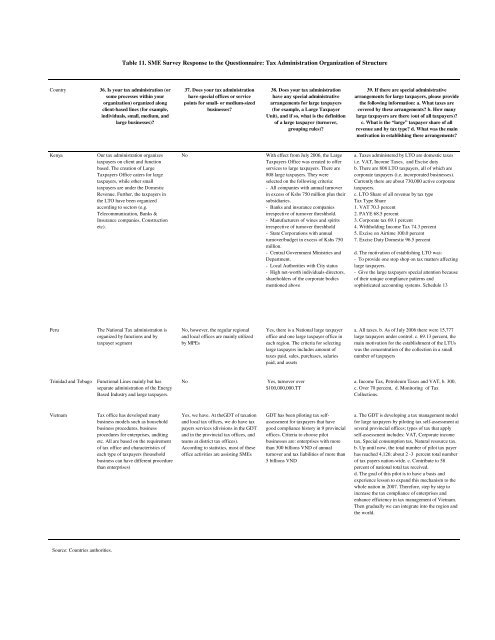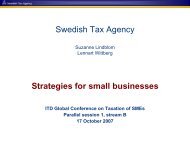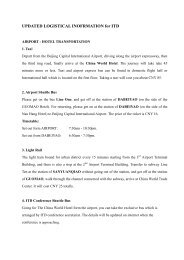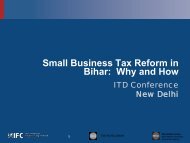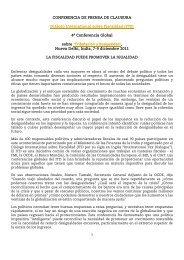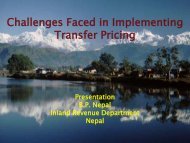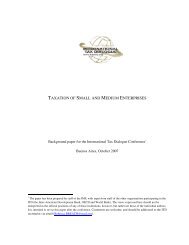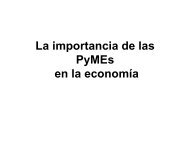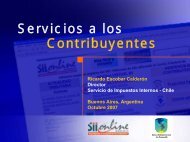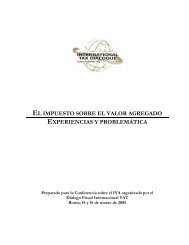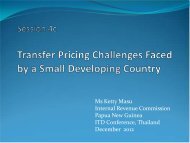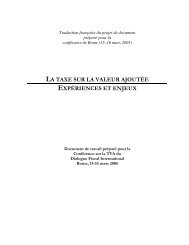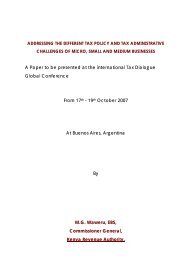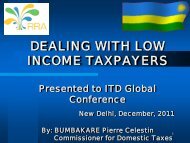PDF format - International Tax Dialogue
PDF format - International Tax Dialogue
PDF format - International Tax Dialogue
You also want an ePaper? Increase the reach of your titles
YUMPU automatically turns print PDFs into web optimized ePapers that Google loves.
Table 11. SME Survey Response to the Questionnaire: <strong>Tax</strong> Administration Organization of Structure<br />
Country<br />
36. Is your tax administration (or<br />
some processes within your<br />
organization) organized along<br />
client-based lines (for example,<br />
individuals, small, medium, and<br />
large businesses)?<br />
37. Does your tax administration<br />
have special offices or service<br />
points for small- or medium-sized<br />
businesses?<br />
38. Does your tax administration<br />
have any special administrative<br />
arrangements for large taxpayers<br />
(for example, a Large <strong>Tax</strong>payer<br />
Unit), and if so, what is the definition<br />
of a large taxpayer (turnover,<br />
grouping rules)?<br />
39. If there are special administrative<br />
arrangements for large taxpayers, please provide<br />
the following in<strong>format</strong>ion: a. What taxes are<br />
covered by these arrangements? b. How many<br />
large taxpayers are there (out of all taxpayers)?<br />
c. What is the “large” taxpayer share of all<br />
revenue and by tax type? d. What was the main<br />
motivation in establishing these arrangements?<br />
Kenya<br />
Our tax administration organizes<br />
taxpayers on client and function<br />
based. The creation of Large<br />
<strong>Tax</strong>payers Office caters for large<br />
taxpayers, while other small<br />
taxpayers are under the Domestic<br />
Revenue. Further, the taxpayers in<br />
the LTO have been organized<br />
according to sectors (e.g.<br />
Telecommunication, Banks &<br />
Insurance companies, Construction<br />
etc).<br />
No<br />
With effect from July 2006, the Large<br />
<strong>Tax</strong>payers Office was created to offer<br />
services to large taxpayers. There are<br />
808 large taxpayers. They were<br />
selected on the following criteria:<br />
- All companies with annual turnover<br />
in excess of Kshs 750 million plus their<br />
subsidiaries.<br />
- Banks and insurance companies<br />
irrespective of turnover threshhold.<br />
- Manufacturers of wines and spirits<br />
irrespective of turnover threshhold<br />
- State Corporations with annual<br />
turnover/budget in excess of Kshs 750<br />
million.<br />
- Central Government Ministries and<br />
Department.<br />
- Local Authorities with City status<br />
- High net-worth individuals-directors,<br />
shareholders of the corporate bodies<br />
mentioned above<br />
a. <strong>Tax</strong>es administered by LTO are domestic taxes<br />
i.e. VAT, Income <strong>Tax</strong>es, and Excise duty<br />
b. There are 808 LTO taxpayers, all of which are<br />
corporate taxpayers (i.e. incorporated businesses).<br />
Currently there are about 730,000 active corporate<br />
taxpayers.<br />
c. LTO Share of all revenue by tax type<br />
<strong>Tax</strong> Type Share<br />
1. VAT 70.3 percent<br />
2. PAYE 68.5 percent<br />
3. Corporate tax 69.1 percent<br />
4. Withholding Income <strong>Tax</strong> 74.3 percent<br />
5. Excise on Airtime 100.0 percent<br />
7. Excise Duty Domestic 96.5 percent<br />
d. The motivation of establishing LTO was:<br />
- To provide one stop shop on tax matters affecting<br />
large taxpayers.<br />
- Give the large taxpayers special attention because<br />
of their unique compliance patterns and<br />
sophisticated accounting systems. Schedule 13<br />
Peru<br />
The National <strong>Tax</strong> administration is<br />
organized by functions and by<br />
taxpayer segment<br />
No, however, the regular regional<br />
and local offices are mainly utilized<br />
by MPEs<br />
Yes, there is a National large taxpayer<br />
office and one large taxpayer office in<br />
each region. The criteria for selecting<br />
large taxpayers includes amount of<br />
taxes paid, sales, purchases, salaries<br />
paid, and assets<br />
a. All taxes. b. As of July 2006 there were 15,777<br />
large taxpayers under control. c. 69.13 percent, the<br />
main motivation for the establishment of the LTUs<br />
was the concentration of the collection in a small<br />
number of taxpayers<br />
Trinidad and Tobago<br />
Functional Lines mainly but has<br />
separate administration of the Energy<br />
Based Industry and large taxpayers.<br />
No<br />
Yes, turnover over<br />
$100,000,000.TT<br />
a. Income <strong>Tax</strong>, Petroleum <strong>Tax</strong>es and VAT, b. 300,<br />
c. Over 70 percent, d. Monitoring of <strong>Tax</strong><br />
Collections.<br />
Vietnam<br />
<strong>Tax</strong> office has developed many<br />
business models such as household<br />
business procedures, business<br />
procedures for enterprises, auditing<br />
etc. All are based on the requirement<br />
of tax office and characteristics of<br />
each type of taxpayers (household<br />
business can have different procedure<br />
than enterprises)<br />
Yes, we have. At theGDT of taxation<br />
and local tax offices, we do have tax<br />
payers services (divisions in the GDT<br />
and in the provincial tax offices, and<br />
teams at district tax offices).<br />
According to statistics, most of these<br />
office activities are assisting SMEs<br />
GDT has been piloting tax selfassessment<br />
for taxpayers that have<br />
good compliance history in 9 provincial<br />
offices. Criteria to choose pilot<br />
businesses are: enterprises with more<br />
than 300 billions VND of annual<br />
turnover and tax liabilities of more than<br />
5 billions VND<br />
a. The GDT is developing a tax management model<br />
for large taxpayers by piloting tax self-assessment at<br />
several provincial offices; types of tax that apply<br />
self-assessment includes: VAT, Corporate income<br />
tax, Special consumption tax, Natural resource tax.<br />
b. Up until now, the total number of pilot tax payer<br />
has reached 4,126; about 2 -3 percent total number<br />
of tax payers nation-wide. c. Contribute to 58<br />
percent of national total tax received.<br />
d. The goal of this pilot is to have a basis and<br />
experience lesson to expand this mechanism to the<br />
whole nation in 2007. Therefore, step by step to<br />
increase the tax compliance of enterprises and<br />
enhance efficiency in tax management of Vietnam.<br />
Then gradually we can integrate into the region and<br />
the world.<br />
Source: Countries authorities.


